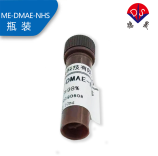Chinese VersionChina Suppliers > Hubei new DE sheng material science and technology co., LTD. > What are the functions of the luminescent reagent acridine ester ME-DMAE-NHS?
- Search Product
-
-
- Region :China/Hubei
- Tel : +86-18971041571
- Fax :
- Email :vickyzhao@whdschem.com
- URL :
- Add :Guanggu United Science and Technology City C8, Ezhou City, Hubei Province
- Details for What are the functions of the luminescent reagent acridine ester ME-DMAE-NHS?
-
What are the functions of the luminescent reagent acridine ester ME-DMAE-NHS?
Category : Other Chemicals/Others

CAS NO : EC NO : MF : MW : Specification : yellow powder. Packing : 10g/bottle Product description : What are the functions of the luminescent reagent acridine ester ME-DMAE-NHS? Acridine ester ME-DMAE-NHS is an important chemiluminescent reagent with unique chemical structure and superior performance, which can be used for labeling and detection of biological macromolecules such as proteins, antibodies, and nucleic acids. Therefore, it has been widely used in biomedical and molecular biology research. Below, we will provide a detailed introduction to its role in various fields. Acridine ester ME-DMAE-NHS is a luminescent reagent with a long chain structure, and its main chemical structure is composed of groups such as maleimide mercaptoethyl and dimethylaminoethyl. This special structure gives it strong affinity on biomolecules and can react with amino and thiol groups in proteins and nucleic acids through nucleophilic reactions, achieving effective labeling. The role it plays is roughly as follows: 1. Acridine ester ME-DMAE-NHS is commonly used for labeling proteins and antibodies in biomedical research. It can react with amino groups (Lysine) in proteins and thiol groups (Cysteine) in antibodies to form stable amide bonds or thioether bonds, introducing chemiluminescence labeling into target proteins or antibodies. This type of marker can play an important role in fields such as biological analysis, immune detection, and drug development. 2. Immunoassay is an important biological analysis technique widely used in early diagnosis of diseases and drug development. Acridine ester ME-DMAE-NHS can be used to introduce fluorescent labels into antibodies, enabling antibodies to bind to specific antigens and generate fluorescent signals, thereby achieving rapid and highly sensitive immune detection. 3. In the field of protein research, acridine ester ME-DMAE-NHS has also been widely used to introduce chemiluminescence labeling into proteins for studying the structure, function, and interactions of proteins. Fluorescence labeled proteins can be tracked in real-time within the organism, thereby better understanding the biological functions of proteins. 4. With the continuous development of biomedical research, it has been found that acridine ester ME-DMAE-NHS also has great potential for application in drug analysis. For example, it can undergo chemical reactions with drug molecules, introduce chemiluminescence labeling into drug molecules, and achieve fluorescence tracing and monitoring of drugs, providing new methods for drug development and efficacy evaluation. Acridine ester ME-DMAE-NHS, as an important chemiluminescent reagent, has broad application prospects in the biomedical field. It achieves efficient labeling of biomolecules by reacting with amino and thiol groups in proteins and antibodies. As an advantageous manufacturer of acridine esters, Desheng can provide customers with six different functional groups of acridine esters to meet diverse needs and save time and cost. At the same time, due to direct sales from the manufacturer, prices can be flexibly adjusted according to the order quantity. If you have any needs, please feel free to contact us! Uses : Chemiluminescence reagent Synonyms : no data
- more>>Other Products
-
- • Biological buffer 3- [N, N-di (hydroxyethyl) amino] -2-hydroxypropanesulfonic acid DIPSO
- • Luminol Sodium Salt
- • 4-Aminophthalhydrazide
- • acridinium ester DMAE-NHS
- • acridinium ester NSP-DMAE-NHS
- • Acridine hydrochloride NSP-SA
- • Acridine hydrochloride NSP-SA-NHS
- • NSP-SA-ADH
- • acridinium ester ME-DMAE-NHS TOOS; 3-(N-Ethyl-3-Methylanilino)-2-Hydroxypropanesulfonic Acid Sodium Salt
- • TOPS; Sodium 3-(N-Ethyl-3-Methylanilino)Propanesulfonate; N-Ethyl-N-Sulfopropyl-M-Toluidine Sodium Salt
- • ADOS Sodium 3-(Ethyl(3-Methoxyphenyl)Amino)-2-Hydroxypropane-1-Sulfonate Dihydrate
- • ADPS N-Ethyl-N-(3-Sulfopropyl)-3-Methoxyaniline Sodium Salt
- • ALPS N-Ethyl-N-(3-Sulfopropyl)Aniline Sodium Salt; Sodium 3-(Ethyl(Phenyl)Amino)Propane-1-Sulfonate; Sodium
- • DAOS; Sodium 3-((3,5-Dimethoxyphenyl)(Ethyl)Amino)-2-Hydroxypropane-1-Sulfonate
- • HDAOS; N-(2-Hydroxy-3-Sulfopropyl)-3,5-Dimethoxyaniline Sodium Salt
- • MADB N,N-Bis(4-Sulfobutyl)-3,5-Dimethylaniline Disodium Salt
- • MAOS N-Ethyl-N-(2-Hydroxy-3-Sulfopropyl)-3,5-Dimethylaniline Sodium Salt Monohydrate
- • DAB 3,3',4,4'-Biphenyltetramine Tetrahydrochloride